
Metro-North Railroad, trading as MTA Metro-North Railroad, is a suburban commuter rail service operated by the Metropolitan Transportation Authority (MTA), a public authority of the U.S. state of New York. Metro-North serves the New York Metropolitan Area, running service between New York City and its northern suburbs in New York and Connecticut, including Port Jervis, Spring Valley, Poughkeepsie, Yonkers, New Rochelle, Mount Vernon, White Plains, Southeast and Wassaic in New York and Stamford, New Canaan, Danbury, Bridgeport, Waterbury, and New Haven in Connecticut. Service in Connecticut is operated under contract with the Connecticut Department of Transportation. Metro-North also provides local rail service within the New York City boroughs of Manhattan and the Bronx.
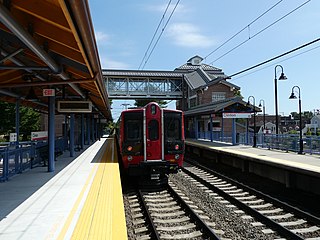
Shore Line East (SLE) is a commuter rail service which operates along the Northeast Corridor through southern Connecticut, United States. The rail service is a fully owned subsidiary of the Connecticut Department of Transportation (CTDOT) and is operated under the CT Rail brand. SLE provides service seven days a week along the Northeast Corridor between New London and New Haven; limited through service west of New Haven to Bridgeport and Stamford has been suspended since 2020. Cross-platform transfers to Metro-North Railroad New Haven Line trains are available at New Haven for service to southwestern Connecticut and New York City. Pre-COVID, around 2,200 riders used the service on weekdays.
Bombardier Transportation was a Canadian-German rolling stock and rail transport manufacturer, with headquarters in Berlin, Germany. It was one of the world's largest companies in the rail vehicle and equipment manufacturing and servicing industry. Bombardier Transportation had many regional offices, production and development facilities worldwide. It produced a wide range of products including passenger rail vehicles, locomotives, bogies, propulsion and controls. In February 2020, the company had 36,000 employees, and 63 manufacturing and engineering locations around the world. Formerly a division of Bombardier Inc., the company was acquired by French manufacturer Alstom on 29 January 2021.
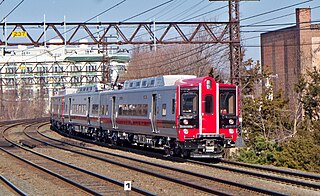
The New Haven Line is a 72.7 mi (117.0 km) commuter rail line operated by the Metro-North Railroad in the U.S. states of New York and Connecticut. Running from New Haven, Connecticut, to New York City, the New Haven Line joins the Harlem Line in Mount Vernon, New York, and continues south to Grand Central Terminal in Manhattan. The New Haven Line carries 125,000 passengers every weekday and 39 million passengers a year. The busiest intermediate station is Stamford, with 8.4 million passengers, or 21% of the line's ridership.

The Danbury Branch is a diesel branch of the Metro-North Railroad's New Haven Line in the U.S. state of Connecticut, running from downtown Norwalk north to Danbury. It opened in 1852 as the Danbury and Norwalk Railroad. Until the early 1970s, passenger service continued north from Danbury to Canaan, Connecticut, and Pittsfield, Massachusetts. Metro-North took over operation of the line from Conrail in 1983, and the modern-day branch is mostly single-tracked.

The Waterbury Branch is a branch of the Metro-North Railroad's New Haven Line, running north from a junction in the Devon section of Milford to Waterbury, Connecticut. Originally built as the Naugatuck Railroad, it once continued north to Winsted. The part north of Waterbury is now leased from CTDOT by the Railroad Museum of New England, which operates excursion trains from Thomaston station through their operating subsidiary Naugatuck Railroad ; this name was chosen in homage of the original railroad. The trackage ends in Torrington, but Metro-North service on the branch ends at Waterbury. There are conceptual plans to extend service from its current terminus in Waterbury to Hartford via Bristol and New Britain. Currently, riders that want to continue to New Britain and Hartford have to transfer to an express bus operated by CTtransit at Waterbury. All trains on this branch operate as shuttles between Waterbury and Bridgeport.

The Budd SPV-2000 is a self-propelled diesel multiple unit railcar built by the Budd Company between 1978 and 1981 for use on North American commuter railroads. The design was a successor to Budd's popular Rail Diesel Car (RDC) but based on the body of the Amfleet passenger car. It did not prove a success: Budd built 31 cars and they proved mechanically unreliable.

The passenger locomotives derivatives of the General Motors EMD GP40 diesel-electric locomotive have been, and continue to be, used by multiple passenger railroads in North America. For passenger service, the locomotives required extra components for providing steam or head-end power (HEP) for heating, lighting and electricity in passenger cars. Most of these passenger locomotives were rebuilt from older freight locomotives, while some were built as brand new models.
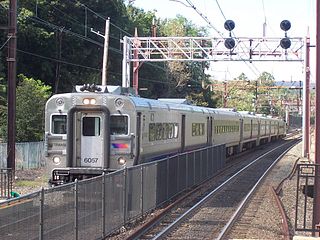
The Comet railcar is a class of locomotive-hauled railcars that was first designed in the late 1960s by Pullman-Standard as a modern commuter car for North American rail lines. Later, the Comet moniker was adopted by NJ Transit for all of its non-powered single level commuter coaches. Additional series of cars bearing the Comet name, based on the original design, have since been built by Bombardier Transportation and Alstom. The successful design was adopted by numerous commuter agencies.

The M2, M4 and M6 were three similar series of electric multiple unit rail cars produced by the Budd Company (M2), Tokyu Car Corporation (M4), and Morrison-Knudsen (M6) for the Metropolitan Transportation Authority (MTA) and the Connecticut Department of Transportation (ConnDOT). Initially branded as the Cosmopolitans, the cars were later more popularly known under their model names, M2, M4, M6. They ran on the New Haven Line for most of their service life.

The Hartford Line is a commuter rail service between New Haven, Connecticut, and Springfield, Massachusetts, using the Amtrak-owned New Haven–Springfield Line. The project is a joint venture between the states of Connecticut and Massachusetts, with support from the federal government as well. CT Rail-branded trains provide service along the corridor, and riders can use Hartford Line tickets to travel on board most Amtrak trains along the corridor at the same prices. The service launched on June 16, 2018.

The M8 is an electric multiple unit railroad car built by Kawasaki for use on the Metro-North Railroad New Haven Line and the CTrail Shore Line East. The fleet of 471 cars first entered service in 2011, replacing the M2, M4 and M6 cars, which entered service in 1973, 1987 and 1994, respectively. An additional 60-car order is currently finishing delivery in response to increased ridership and usage on Shore Line East.
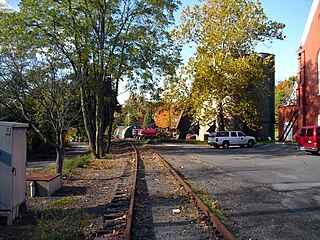
The Metro-North Railroad's Beacon Line is a non-revenue line connecting the railroad's three revenue lines east of the Hudson River. From west to east, the lines that connect are Hudson Line, Harlem Line, and the Danbury Branch of the New Haven Line. It was purchased by Metro-North in 1995 for $4.2 million from Maybrook Properties, a subsidiary of the Housatonic Railroad, to preserve it for future use, training, and equipment moves. Maybrook Properties purchased the line from Conrail after Conrail withdrew from the Danbury, Connecticut, freight market in 1992.

The Comet V railcar is the fifth generation of the Comet railcar series. Produced by the manufacturer Alstom, the Comet V is a rather different car compared to previous models in the series. The Comet V has been in use by New York metropolitan area commuter rail operators New Jersey Transit and Metro-North since April 2002.

The Mafersa coaches are a class of 38 passenger railroad cars built by Brazilian manufacturer Mafersa. Originally built for Virginia Railway Express (VRE) in 1991–92, they are currently operated by Connecticut Department of Transportation (CTDOT) and QIT-Fer et Titane.
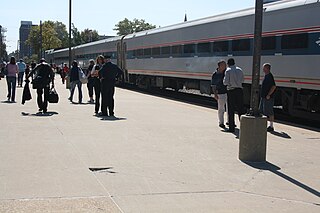
The Horizon is a type of single-level intercity railroad passenger car used by Amtrak, the national rail passenger carrier in the United States. Amtrak ordered the cars to supplement their existing fleet of Amfleet I single-level cars used on shorter distance corridor trains. The design was based on the Comet railcar used for commuter railroads, but with modifications to make them more suitable for intercity service. Bombardier Transportation built 104 cars from 1988 to 1990 in two basic types: coaches and food service (café) cars.

The MultiLevel Coach is a bi-level passenger rail car for use on commuter rail lines. Originally built by Bombardier Transportation beginning in 2006, they are now built by Alstom since 2021, who markets the coaches as part of their Adessia Coach series.
The Metro-North Railroad is a commuter railroad serving northern suburbs of New York City. It principally uses a fleet of electric railcars for its services; diesel locomotives and push-pull coaches are in use as well for non-electrified portions of the system.

CT Rail, stylized as CTrail, is the brand for commuter rail services overseen by the Connecticut Department of Transportation (CTDOT), in the U.S. state of Connecticut, with some service extending into Massachusetts. CTDOT oversees two lines: Shore Line East, between New Haven and New London, Connecticut, and the Hartford Line, from New Haven, through Hartford, to Springfield, Massachusetts.

















